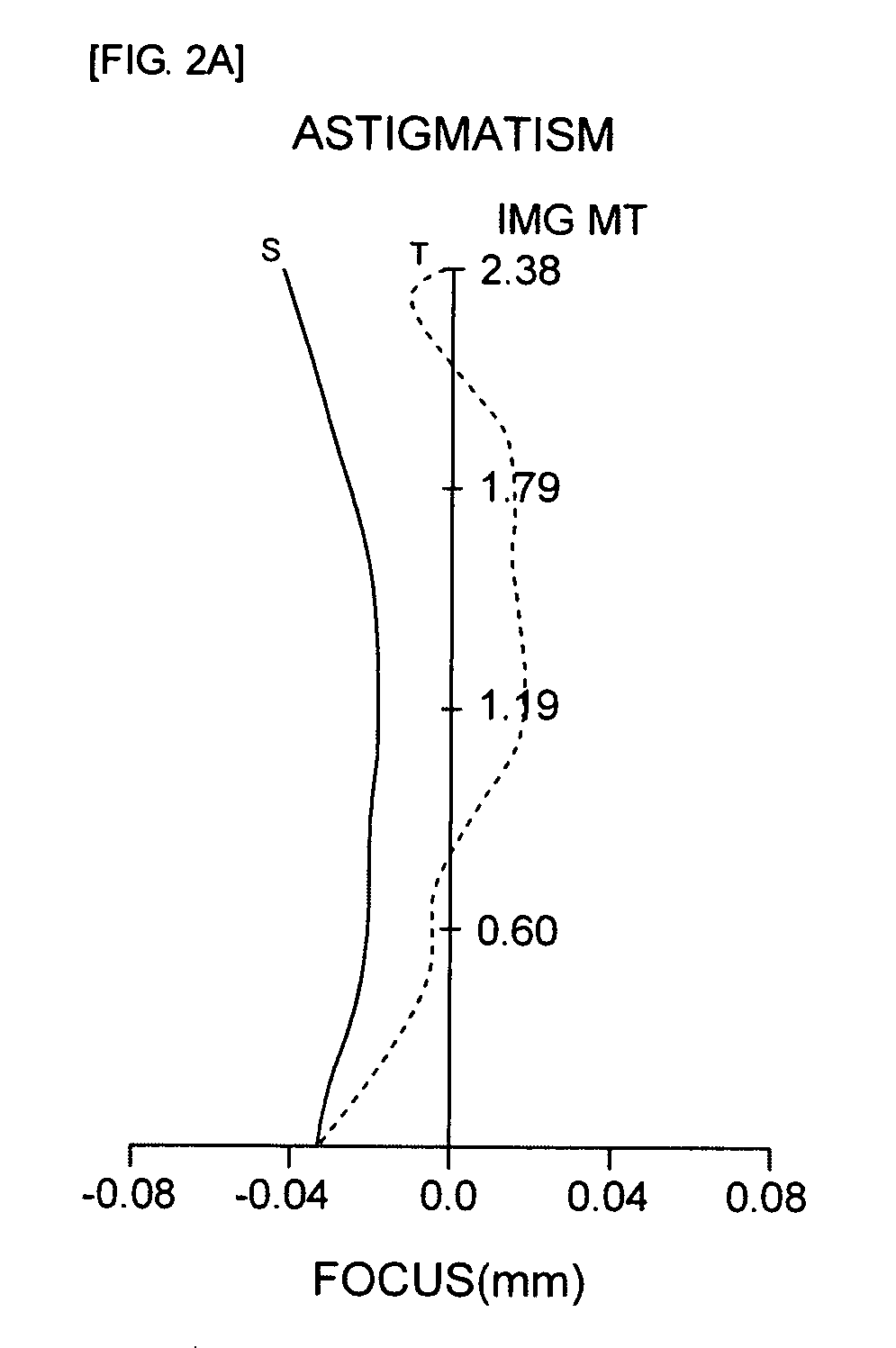Optical system for camera
a technology of optical system and camera, applied in the field of optical system for camera, can solve the problems of deteriorating design flexibility of optical system, difficult to meet the optical performance, and the size of the optical system mounted in the mobile communication device, so as to improve the design flexibility, reduce the size of the first lens, and improve the effect of adjacent aberration characteristics including astigmatism and distortion aberration
- Summary
- Abstract
- Description
- Claims
- Application Information
AI Technical Summary
Benefits of technology
Problems solved by technology
Method used
Image
Examples
first embodiment
[0073]Table 1 shown below shows a value example in accordance with the first embodiment of the present invention.
[0074]Further, FIG. 1 is a configuration diagram showing a configuration of lenses of an optical system for a camera in accordance with a first embodiment of the present invention, FIGS. 2A and 2B show astigmatism and distortion aberration of an optical system shown in Table 1 and FIG. 1, respectively, and FIGS. 3A to 3D are diagrams of coma aberration for each field in accordance with a first embodiment. In addition, in the astigmatism diagram of FIG. 2A, ‘S’ represents sagital and T represents tangential.
[0075]In the first embodiment, a view angle is 64 degrees, a distance TL from an object-side surface 1 to the top surface of the first lens L1 is 4.2 mm, and an effective focus distance f of the entire optical system is 3.6 mm. Further, the first lens L1 to the fourth lens L4 all are configured by plastic lenses.
TABLE 1AbbeSurfaceCurvatureThickness orRefractiveNumberNum...
second embodiment
[0078]Table 3 shown below shows a value example in accordance with the second embodiment of the present invention.
[0079]Further, FIG. 4 is a configuration diagram showing a configuration of lenses of an optical system for a camera in accordance with a second embodiment of the present invention, FIGS. 5A and 5B show astigmatism and distortion aberration of an optical system shown in Table 3 and FIG. 4, respectively, and FIGS. 6A to 6D are diagrams of coma aberration for each field in accordance with a second embodiment. In addition, in the astigmatism diagram of FIG. 5A, ‘S’ represents sagital and ‘T’ represents tangential.
[0080]In the second embodiment, the view angle is 50 degrees, the distance TL from the object-side surface 1 to the top surface of the first lens L1 is 5.5 mm, and the effective focus distance f of the entire optical system is 5.5 mm. Further, the first lens L1 to the fourth lens L4 all are configured by the plastic lenses.
TABLE 3AbbeSurfaceCurvatureThickness orRef...
third embodiment
[0083]Table 5 shown below shows a value example in accordance with the third embodiment of the present invention.
[0084]Further, FIG. 7 is a configuration diagram showing a configuration of lenses of an optical system for a camera in accordance with a third embodiment of the present invention, FIGS. 8A and 8B show astigmatism and distortion aberration of an optical system shown in Table 5 and FIG. 7, respectively, and FIGS. 9A to 9D are diagrams of coma aberration for each field in accordance with a third embodiment. In addition, in the astigmatism diagram of FIG. 8A, ‘S’ represents sagital and ‘T’ represents tangential.
[0085]In the third embodiment, the view angle is 60 degrees, the distance TL from the object-side surface 1 to the top surface of the first lens L1 is 3.8 mm, and the effective focus distance f of the entire optical system is 3.8 mm. Further, the first lens L1 to the fourth lens L4 all are configured by the plastic lenses.
TABLE 5AbbeSurfaceCurvatureThickness orRefract...
PUM
 Login to View More
Login to View More Abstract
Description
Claims
Application Information
 Login to View More
Login to View More - R&D
- Intellectual Property
- Life Sciences
- Materials
- Tech Scout
- Unparalleled Data Quality
- Higher Quality Content
- 60% Fewer Hallucinations
Browse by: Latest US Patents, China's latest patents, Technical Efficacy Thesaurus, Application Domain, Technology Topic, Popular Technical Reports.
© 2025 PatSnap. All rights reserved.Legal|Privacy policy|Modern Slavery Act Transparency Statement|Sitemap|About US| Contact US: help@patsnap.com



